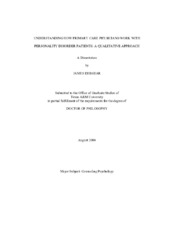| dc.contributor.advisor | Lawson, David | |
| dc.creator | Deegear, James Otis | |
| dc.date.accessioned | 2004-11-15T19:53:53Z | |
| dc.date.available | 2004-11-15T19:53:53Z | |
| dc.date.created | 2004-08 | |
| dc.date.issued | 2004-11-15 | |
| dc.identifier.uri | https://hdl.handle.net/1969.1/1288 | |
| dc.description.abstract | The purpose of the present study was to begin to develop an understanding of how primary care resident physicians work with patients with personality disorder-type characteristics and processes. Participants include fifteen primary care resident physicians from a community health clinic. Participants individually viewed two video vignettes of an actor-patient being interviewed by a physician. Participants were asked how they would respond to statements the actor-patient made during the course of watching the video and then answered general questions about reactions to the actor-patient and working with patients with personality disorders.
Using a naturalistic qualitative analysis, data were analyzed for categories and themes. The results of the analyses are presented within a basic framework for understanding how primary care residents work with and approach the doctor-patient relationship, and treat patients with personality disorder characteristics and associated personality processes.
Broad themes emerge from the data. Content of residents' responses suggests two response styles: attention to patient's presenting physical concern or identify and potentially address underlying psychological and emotional concerns. Residents characterize the establishment of a relationship with this patient population as either a distancing, paternalistic approach, or an engaging and collegial relationship. Levels of self-awareness of reactions to patients consist of either a willingness to address personal reactions or a tendency to not identify or discuss those reactions. Residents also demonstrate a dichotomous response to willingness to work with this patient population characterized by either hesitancy to do so, or a desire to engage and attempt to work with these patients.
A framework for understanding the possible effects and motivating variables behind these styles is presented. The predominant effects of the residents' interactions styles are either a distancing/paternalistic relationship or an engaging/collegial relationship. Two themes appear to characterize residents' motivations: the resident was driven by self-needs or patient-needs.
These results may be useful in developing an initial theory of this previously unexamined dynamic. Moreover, these results may be useful in helping physicians better develop relationships with patients, especially through improvement in recognizing and utilizing personal reaction to patients. Future inquiries directed towards understanding what physician variables contribute to these two basic interaction styles identified here may be useful. | en |
| dc.format.extent | 1136640 bytes | en |
| dc.format.extent | 491352 bytes | en |
| dc.format.medium | electronic | en |
| dc.format.mimetype | application/pdf | |
| dc.format.mimetype | text/plain | |
| dc.language.iso | en_US | |
| dc.publisher | Texas A&M University | |
| dc.subject | personality disorders | en |
| dc.subject | primary care | en |
| dc.subject | doctor-patient relationship | en |
| dc.title | Understanding how primary care physicians work with personality disorder patients: a qualitative approach | en |
| dc.type | Book | en |
| dc.type | Thesis | en |
| thesis.degree.department | Educational Psychology | en |
| thesis.degree.discipline | Counseling Psychology | en |
| thesis.degree.grantor | Texas A&M University | en |
| thesis.degree.name | Doctor of Philosophy | en |
| thesis.degree.level | Doctoral | en |
| dc.contributor.committeeMember | Brossart, Dan | |
| dc.contributor.committeeMember | Duffy, Michael | |
| dc.contributor.committeeMember | DeVaul, Richard | |
| dc.type.genre | Electronic Dissertation | en |
| dc.type.material | text | en |
| dc.format.digitalOrigin | born digital | en |


